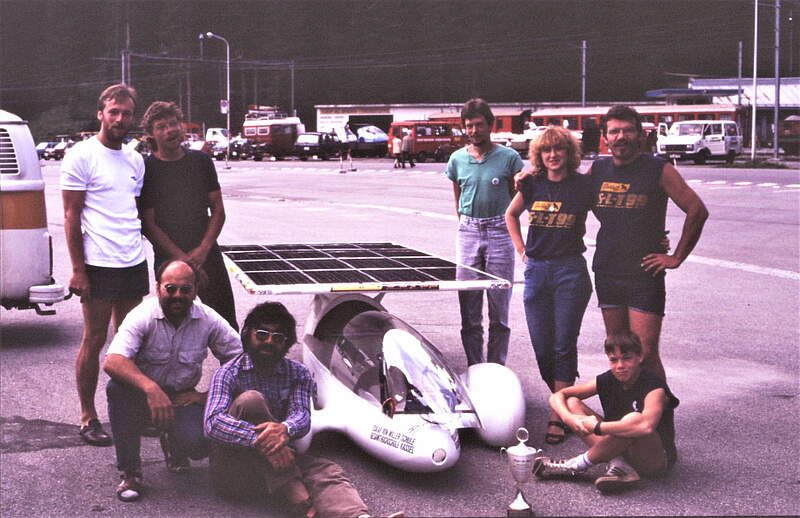A start into new times - once a solar mobile, today a pedelec: Rohloff delivers drives for clean mobility
It used to seem like a vehicle of the future: the racing solar mobile „Dyname“, which was designed and built by students of the university Kassel in 1987, together with vocational school teachers. One year earlier, Bernhard Rohloff, who had founded the Rohloff GmbH, specialized for bike chains with his wife Barbara, supported the team in the contruction of a light drive.
In one of Kassels professional schools, the Oskar von Miller school, everyone involved worked together to bring the oval-shaped capsule, which offered space for the pilot, on the street. On the roof a solar panel to power the engine. Goal: the Tour de Sol' 87, a quite new Solarrallye in Switzerland.
Bike chain as the drive for the solar mobile
A crew actually started and was on the way for seven days and six stages with 95 additional teams from Biel to Arosa. And successfully: A biker from Kassel called Thomas Jeltsch with the start number 89 ranked first with a time of 10:11,23 in one of four Championship categories: racing solar mobile with help drive – in this case muscle powered pedals. It was driven by the first Rohloff S-L-T-99-chain, which at that point wasn't even available for bikers.
It was brought to the market in 1988. In Switzerland there were Barbara and Bernhard Rohloff with their 12-year-old son Mirco, for which the Rallye was an adventure: „The interest was overwhelming. thousands of people, schools even closed just for this, they stood by the streets, looked at what was happening and cheered for us“ , the electrical engineer remembers. For him, the days were like starting into new times. Heino Kirchhof by the way also belonged to the supporter-team of the „Dyname“, under who's leadership the solar association of Kassel was founded, shortly after the Solarrallye. Today he engages in the german society for solar energy and is deputy chair of the section in Kassel.
Premium products for the bike industry
Back to the company Rohloff: Today the company, which is registered as Rohloff AG since 2004, stands for highend technology in bike drives. The bike hubs from Fuldatal are one of the premium products of the industry. The Rohloffs set the base with their bike chain S-L-T 99, which was considered a technological milestone. The ninefold chain, which had between 110 and 116 links, was ahead of her time, Mirco Rohloff explains.
Almost 10 years later, the japanese manufacturer Shimano launched the first ninefold circuit. What was so special about the S-L-T-99, was its long durability and the precision in changing gears, based on the patented „Super Link Technologie“. The wear could be noticeably reduced, because of the geometry optimization of the power-transmitting parts on the chain link. Also: The chain was compatible with all existing switching systems.
Convincing even bike pros with the quality
After the Rohloffs had presented the S-L-T-99 at the fair in 1988, it became the „secret recipe“ of the bike mechanics, because it switched cleaner than the others. In the 90s this also made it a trendy component amongst the bike pros of the Tour de France. From 1988 on, there were up to 10.000 being produced per month. In 1989 the bike component Campagnolo joined the company Rohloff: The italians equipped their drive groups with the circuit chain from Kassel for four years, so that there were 2000 being delivered per week.
While the bike pros were still amazed by the Rohloff-chain, the construction of the Speedhub 500/14 began in Kassel. It's considered the only hub gear with 14 gears, that can completely replace conventional hubs in terms of frictional losses and scope of translation. It was introduced in 1996 and produced over 350.000 times up to this day. „There are a ton of people who can travel around the world with our hub without any problems. The current top number is 435.000 kilometers. The hub still works and the number further increases“, tells Mirco Rohloff and executive Werner Schiller happily. It's extremely durable and the lightest one on the market.
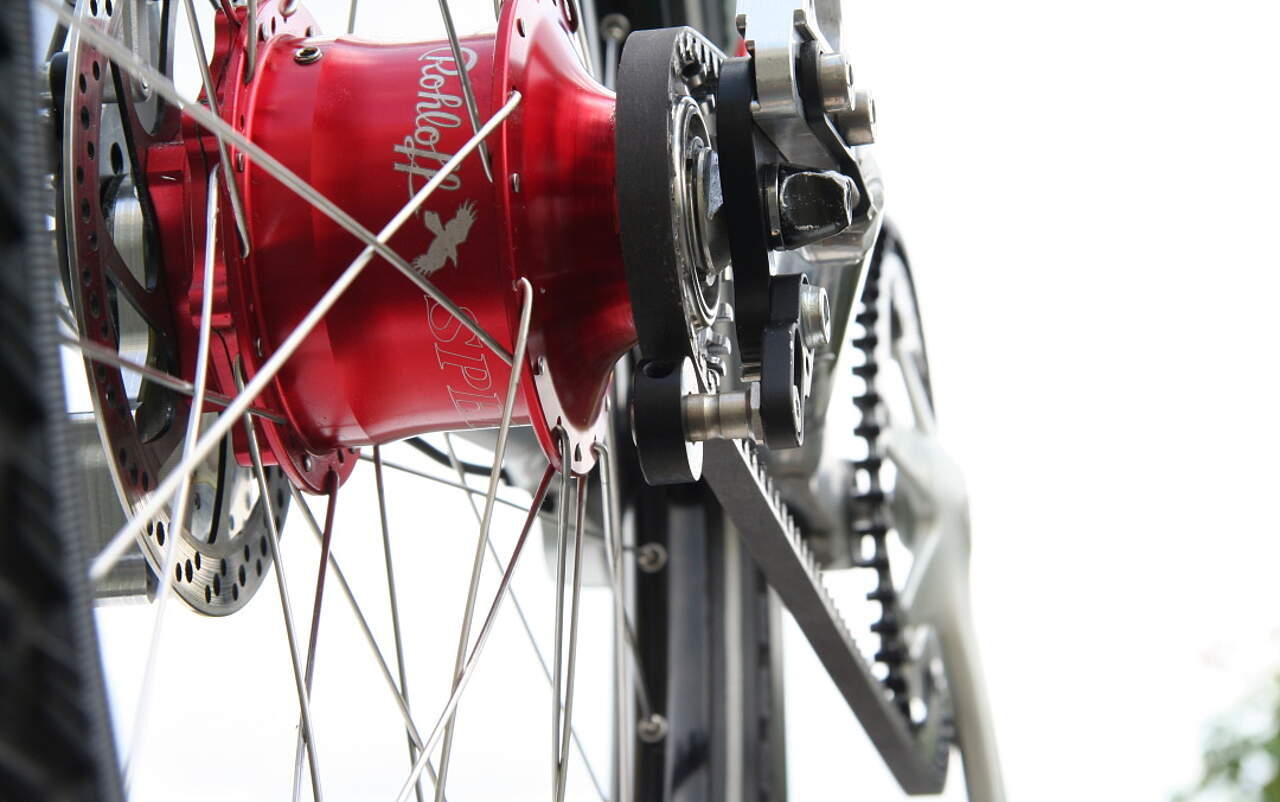
Sustainability is company philosophy
The Speedhub stands for the company credo: „Safety, reliability, athleticism. We always want to be one step ahead.“ 65 employees make their contribution from the construction to the quality check. Quality is also made sure by 150 partners in germany, which construct and deliver the parts, that get assembled in Fuldatal. 95 percent of the components get delivered to bike manufacturers, besides that to importers, merchants and service partners. They value its long durability and sustainability: „Even after twenty years, we maintain and repair Speedhub gear hubs and therefore offer long-term, reliable mobility“, says Mirco Rohloff.
But the sustainability not only shows in the products, but also in the production. Therefore Rohloff Ag decided to produce needed electricity with a solar system on the roof. Though this was not an easy task, tells Mirco Rohloff, because there had to be a way without damaging the 25 year old gras roof.
Solar electricity makes production more ecological
„We couldn't find a company, that wanted to do this for us, so we had to look for a montage system, that carries the roof“ explains Mirco Rohloff, that has the same ambition as his father to improve things like wearing parts of a bike chain or a hub. The solution turned out to be a solar system, that swims on the grass roof and has the power of 45 kilowatts peak.
This way, eighty percent of the annual reqirement for electricity in the production is created with photovoltaic today. The left-overs go into a heat pump, which cools in the summer and warms in the transition months – and minimizes the gas consumption. An important step for family Rohloff to manufacture their products more economically.
„We built a solar system for 600 euros per kilowatt peak. This way it amortizes itself because of the cheap construction and the high self-consumption in the course of just three years.“ explains Mirco Rohloff. There were only branded components used for approximately one thousand square meters of roof area: 340 watt modules from the company Solarfabri for the generator, the modular system „FlatFix Fusion“ for the flat roofs of Esdec as a bracket and also three SMA tripower inverters, that are controlled by the SMA-Homemanager 2.
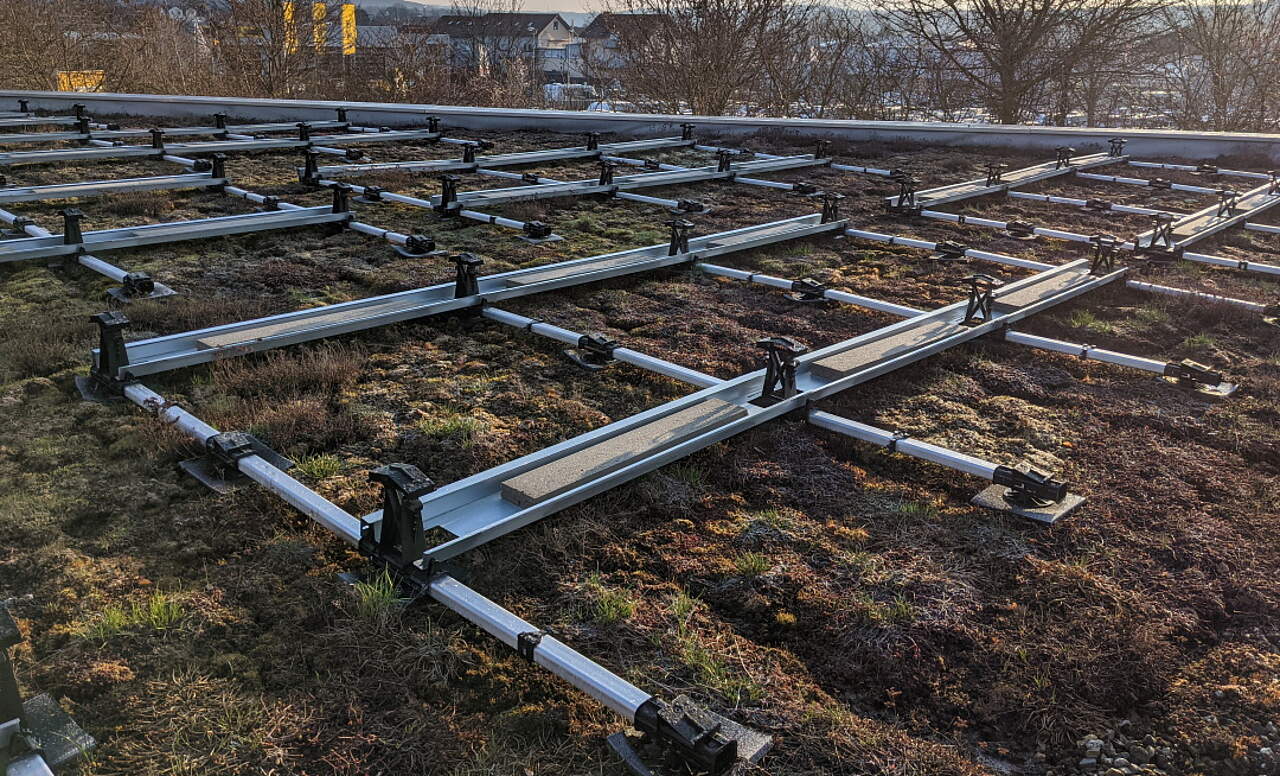
The roof construction for the solar system
It's not exactly an easy mission to put a photovoltaic system on a run down gras roof. You need a montage system, that doesn't damage the roof and at the same time is suitable for the grass growth. The Rohloff AG in Fuldatal wanted to take this step with a specialist company, but couldn't find anyone, who wanted to coorperate. „So we figured out how to do it ourselves“, tells Mirco Rohloff. One of the requirements was for the solar units to be movable for maintenance and repair. Another was for the system to allow enough sunlight through so the grass can continue to grow underneath. And a third important point for the plan: the system should amortize itself fast. One burden was, that the grass on the roof was uneven. So there had to be a system, that would only lie on top selectively and whose connections run a little above the sod.
„We found a good solution with the Esdec-system FlatFix Fusion. Though this system is not actually suited for this case, it works nontheless. The support points are lined with 20 milimeter thick building protection mats in the size of 20x20 centimeters“, explains Mirco Rohloff. This spreads the weight on the support points very well. The solar cells are arranged in groups of six with one meter inbetween, which makes the module groups movable at any time. Thrice the amount of concrete had to be used to fixiate the system safely, because there were no wind deflectors used, so that enough light would pass through the modules.
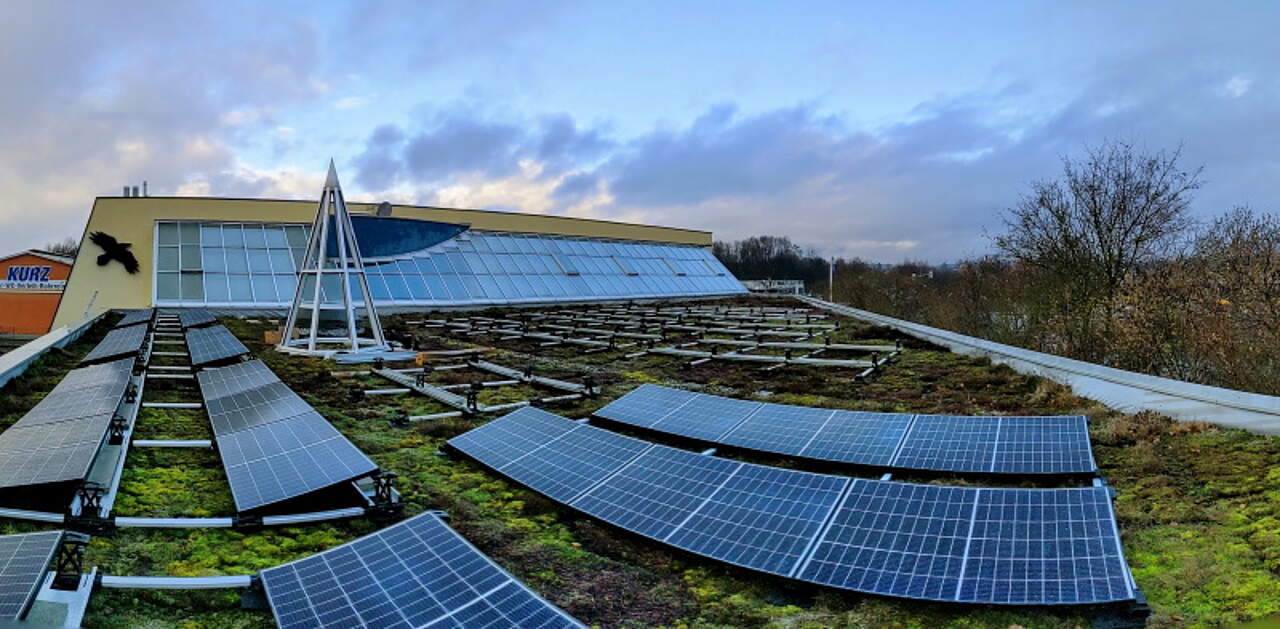
Raising awareness for energy
Employees experience how it's going for generation and consumption in real time on the coffee machine. A Display shows, how much is being generated and how much is comsumed, whether excess can be fed into the power grid or electricity must be purchased. Mirco Rohloff finds this important to raise awareness for energy, especially in times of resources becoming less and less and eletricity and gas becoming more expensive. The coffee machine is a good place for this, because everybody stays here for a bit. And also the employees get a good feeling, knowing it's being produced with sustainable energy. Beyond that, the halls are provided with LED-lamps and new thermal discs, that decrease the energy consumption.
Visualization of the consumption
The Rohloff AG took a long time to find a good solution to visualize the energy consumption of the company. The problem: most of them don't show the consumption in real life time. „We can recommend two programs, that are able to display the consumption quickly via Modbus.“, says Mirco Rohloff. On one hand the „Energy Meter“ app of Heiko Prüssing, that also displays the classical SMA homemanager view. This is quickly installed on the iPad, put into operation in 5 minutes and runs very stable.
https://apps.apple.com/de/app/energy-meter/id989638672
The softwareproject „Solaranzeige“ (solar display) is very good for everyone who has more time and needs more flexibility and freedom. „It runs very well on a Raspberry Pi. Here you can also analyze mixed nets and you're very free in the depiction“, explains Mirco Rohloff.
www.solaranzeige.de
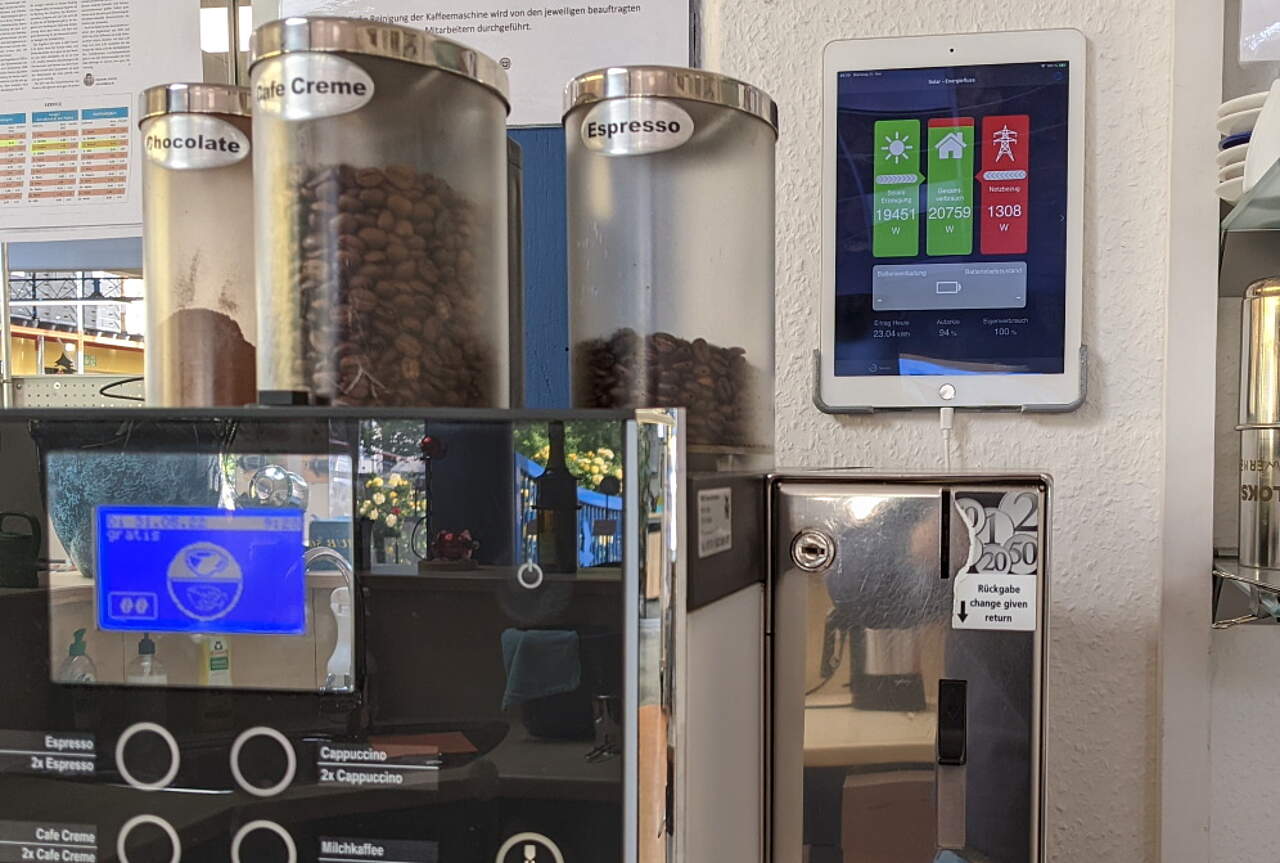
E-mobility needs a good infrastucture
Mirco Rohloff grew up in the business of his parents. The electrical engineer is a member of the supervisory board and especially important when it comes to developments for e-bikes – for example the electronical shift control Rohloff E-14. For him the bike, and especially the e-bike, is the vehicle of the future to get through the climate and mobility change.
The e-bike or the Pedelec are becoming more and more interesting due to growing climate awareness: It makes driving easier, even on climbs and with luggage and therefore is the ideal model for groceries and family trips or job commuters. Long distances are no problem thanks to modern drives and batteries that can be easily charged at home.
Though, it's looking totally different for Mirco Rohloff with e-cars: for many people neither charging station infrastructure and charging time nor the performance of the batteries are good enough to be an „actual alternative“ for the conventional car. For him the e-car still have too many limitations as opposed to a car with a combustion engine like for example long charging times and complicated fuel cards. The e-bike beats the classical bike with a wider range, relaxed, jam-free biking, fast reload and cheap upkeep.
The Tour de Sol, that celebrated its premiere in 1985, was the first race for vehicles, that drove with a solar drive intead of a combustion engine. „I was told back then, that the electro mobility is only a few years ahead. And also, that there was only the battery problem left to be solved, but that this was going to be done in maximum five years“ remembers Mirco Rohloff. „Today we're still at this very same problem.“
E-bikes an important pillar of the traffic turnaround
„Today, 35 years later, my kids could sit on the foto (look at the first upper picture, i was just 13 years old), but neither did we solve the battery problem, nor did we create an infrastructure for charging. Not like my light-hearted childhood, they have to worry about the climate change. Unfortunately I have to tell you, that the electro mobility may still take a while“, he pities.
For him the e-bike is the urban mobility of the future: „Bikes have less CO2 output and take up less space in the ongoing and stillstanding traffic“, he mentions as positive points for the climate protection account. He is proud, that the business of his parents has been offering cleaner mobility for more than 36 years now – and eversince contributes to more climate protection.
Mirco Rohloff thinks, that lighter, smaller and therefore more economical vehicles belong on the streets due to the required traffic turnaround. For him that means: away from the SUV, that is still getting pushed by the car industry. The racing solar mobile „Dyname“, which he admired as a child, stands for thrift, lightweight contruction and efficiency.
„The new and now coming generation of lightweight vehicles L5e to L7e will, in my opinion, play an important role in the traffic of the future together with the Pedelecs, because both fulfill the general conditions. Now the only thing that's missing is the speed limit on german highways“, say Mirco Rohloff – and adds, that this will probably still take a while.
Published: This article was written for the magazine SONNENENERGIE
Autors: Helga Kothe & Mirco Rohloff
